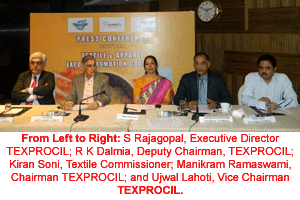
Cotton industry deserves higher incentives: Texprocil
Cotton yarn exports touched $4.5 billion, and cotton fabric $2.13 billion during 2013-14. Cotton home textiles achieved exports of $4.79 billion, according to TEXPROCIL.
Cotton yarn exports touched $4.5 billion, and cotton fabric $2.13 billion during 2013-14. Cotton home textiles achieved exports of $4.79 billion, according to TEXPROCIL (Cotton Textiles Export Promotion Council.) This was disclosed at a recent TEXPROCIL press conference held in Mumbai.
According the reckonings of TEXPROCIL, Indian yarn and made-up exports were impacted due to the following reasons:
1. Indian cotton prices remained higher than international cotton prices since February. With cotton prices higher than international prices?70 per cent of its sale value of yarn is cotton cost?it is extremely difficult even for the highly efficient spinning sector to export its products.
2. Home textiles exports got impacted as Indias main competitor, Pakistan, in the EU main market gained zero duty access, against 9.6 per cent customs duty for products from India.
3. Fabric exports have seen a small increase on a small base due to improved penetration into markets where India enjoys duty free access
TEXPROCIL?s recommendations to ensure growth in exports as targeted at $13.5 billion are:
1. Cotton Corporation of India (CCI) which is a well staffed cotton procurement and sales organization , which at present does support price operations must be mandated to use its reach and procure cotton during periods when Indian cotton is available cheaper than International prices and off load it at regular intervals whenever there is a threat of cotton prices breaching the international prices to Mills.
This will benefit farmers, as they will get higher prices during the harvest period. It will also benefit the mills as they will not be impacted by the large traders who use their holding capacity and ability to sell futures in NY market to cause the Indian prices to go over the international prices for 6 months each year.
CCI will be able to use its 600 strong human resource at all times and prove its worth by making commercial operations and profits. CCI will need to broad base its board to include stake holders to give commercial wisdom. As of today, one joint secretary and three executives paid by government alone are directors of a huge commercial organisation.
2. In order to overcome the external barriers and restore a semblance of level playing field, the Foreign Trade Policy (FTP) should address the issues appropriately.
Foreign Trade Policy has four broad objectives:
1. Maximise Indias forex earnings for a given incentive outflow
2. Create maximum number of jobs for a given incentive outflow
3. Incentivise exports of products/commodities that has head room to grow , incentives should increase exports and not merely add to the bottom line of exporters
4. Incentives should offset the extra freight costs incurred while exporting to distant markets
On all four points, cotton textile exports be it yarns , fabrics or ?Cut and Sew? deserve higher incentives than engineering exports, electronic assembled products like set up boxes, furniture, bicycles, two wheelers, etc as textiles has near zero import content, as against 25-90 per cent import content in the above listed products
Textiles create 10 to 20 times more jobs than the listed products and that too in tier 3/4 locations for unskilled persons of both sexes.
Indian textile exports at the best is 10 per cent in most markets and there is a 90 per cent head room for growth should we become price competitive and displace our competitors from our neighbourhood.
Textiles have lower FOB value and therefore suffer higher logistic costs in percentage terms and therefore deserve a higher percentage as focus market incentives to offset the extra freight cost than listed products.
However the reality is that the FTP is not implemented as per stated objectives and textiles enjoy lowest instead of highest incentives. TEXPROCIL wants the government to state the policy and follow it and not do just the opposite.
Following the policy with a logic of g




